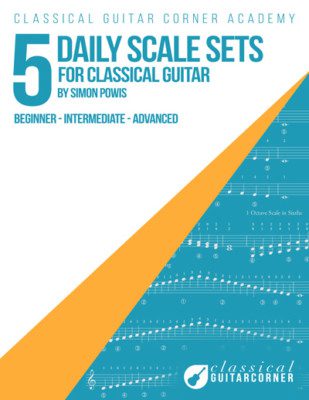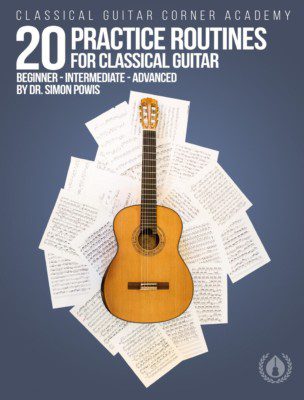Classical guitar scales are fundamental building blocks of the music we play. They form the basis of both melody and harmony, while also being essential for developing finger strength, dexterity, and musical understanding. Practicing scales can significantly enhance your technical ability and overall musicianship.
Understanding Scales
What Are Scales?
A scale is a sequence of notes ordered by pitch, typically spanning an octave. Scales are the foundation of Western music, providing the framework for melodies and harmonies. Each scale consists of a specific pattern of intervals (the distance between notes), which gives it a unique sound and character.
Types of Scales
There are various types of scales, each with its distinct structure and sound. The most common types are:
- Major Scales: Bright and happy sounding, major scales are built with a specific pattern of whole and half steps.
- Minor Scales: Generally darker and more somber, minor scales come in three variations: natural, harmonic, and melodic.
- Chromatic Scales: These scales include all twelve notes within an octave, each a half step apart.
The Role of Scales in Music Theory
In music theory scales form the basis for chords, chord progressions, and melodies. We build triads off of scale degrees, which are the basis of block chords and arpeggios; we connect those chords together in progressions that express tension and resolution; and we use notes of the scale to craft melodies of all sorts. Thus, understanding scales can help you unlock other aspects of your musical knowledge.
Basic Scales for Beginners
Major Scales
Explanation and Structure
The major scale consists of seven notes plus an octave and follows a specific pattern of whole steps (W) and half steps (H):
- Pattern: W-W-H-W-W-W-H

The Major Scale Formula
Example: C Major Scale

C Major Scale
Practice Tips
- Use alternation in the right-hand between i and m (index and middle), even when crossing strings.
- Start slowly, focusing on the accuracy and clarity of each note.
- As you ascend on one string you can leave fingers down to increase legato (how well notes connect to each other).
- Likewise, as you descend you can prepare fingers early to improve that same connection.
Watch more Major scales lessons:
- C major scale on guitar
- G Major scale on guitar
- A Major scale on guitar
- E Major scale on guitar
- D Major scale on guitar
- F Major scale on guitar
Minor Scales
Natural, Harmonic, and Melodic Minor Scales
Minor scales have a different structure and sound compared to major scales. There are three main types of minor scales:
- Natural Minor Scale: Follows the pattern W-H-W-W-H-W-W. Another way to think of it is that it is the same as the major scale but starting from the sixth note.
- Harmonic Minor Scale: Similar to the natural minor but with a raised seventh note (or leading tone), creating a distinct sound.
- Melodic Minor Scale: Ascending, it has a raised sixth and seventh note, but descending, these notes are natural once again.
Example: A Minor 2 Octave Scale

Practice Tips
- There is a big stretch when you reach the G# on the first string. Allow your first finger to extend, almost pushing your hand into second position to allow the 3 to reach the G#.
- As you descend and reach the G# again, you can begin extending the 1 back to first position to reach the F and allow the rest of the hand to follow once you play it.
- This scale is longer so try not to rush. Maintain a steady pulse with control and accuracy.
Watch more minor scales lessons:
Chromatic Scales
Structure
The chromatic scale includes all twelve notes within an octave, each a half step apart. This scale is useful for developing finger independence and agility. A chromatic scale in first position provides an excellent framework to practice fingertip placement, string crossing, and stretch in the left hand.
Example: Chromatic Scale

Practice Tips
- Be sure to place each finger snug up against the fretwire.
- To make it easier you can leave fingers down when ascending and prepare them early when descending.
- The transition between the thumb playing bass notes and i-m alternation playing the trebles should be seamless. Practice that transition to make sure it is smooth.
Techniques for Practicing Classical Guitar Scales
Right-Hand Alternation
Developing a regular and relaxed alternation between fingers in the right hand will allow you to play with speed and relaxation. One tendency for beginners is to repeat right-hand fingers, something that often happens when crossing strings. Scale practice can thus be a great way to build up a habit of alternation.
Exercise
- Start with the index finger (i) on the first note, followed by the middle finger (m) on the second note, and continue alternating even as you cross strings.
- Practice slowly, focusing on the evenness of your strokes and the clarity of each note.
- Say what finger you are playing out loud. This can help you catch when you accidentally repeat a finger.
- It is okay to repeat fingers in some instances, such as on longer held durations.
Legato Playing
Legato means connected and it is important to develop a smooth, connected way of playing. This is especially important on the guitar because it is such a percussive instrument and notes die away so quickly. While the concept is simple, the execution can be challenging on classical guitar. There will always be a tiny disconnect between two notes on the same string because the right-hand needs to re-pluck the string. Your job is to reduce this gap so that it is almost absent.
Stacatto Exercise
- Start by exaggerating the problem and play stacatto scales that stop the sound between each note.
- Use both right-hand and left-hand stacatto in this exercise as both hands play a role.
Legato Exercise
- Normally we would recommend slow practice to build up new techniques. However, the slower you go the more difficult it will be to connect notes in a smooth way. So find a tempo that is manageable but not so slow that you struggle to connect notes together.
- Focus on a quick but relaxed movement in the left-hand with accurate placement of the fingertip.
- Make sure that you are not resting your right-hand fingers on the string before you play.
Using a Metronome
Practicing with a metronome helps you develop a strong sense of timing and rhythm. It ensures that you maintain a consistent tempo while playing scales.
Exercise
- Set the metronome to a comfortable tempo (e.g., 60 beats per minute).
- Play a scale (e.g., A minor) in time with the metronome, ensuring each note falls precisely on the beat.
- If you find your rhythm is a little off, try using subdivision on your metronome: 120 beats per minute in this case. Now instead of having one click per beat, you’ll have two. This can give you a bit more feedback for each beat and make it easier to come in on time.
Practicing with Different Rhythms and Articulations
Incorporating various rhythms and articulations into your scale practice can make it more interesting and challenging.
Exercise
- Scales can be great for practicing difficult rhythms, like dotted rhythms, syncopations, triplets, and so on.
- Play the scale using different rhythmic patterns (e.g., eighth notes, triplets, sixteenth notes).
- Experiment with various articulations, such as staccato (short and detached) or legato (smooth and connected).
Incorporating Dynamics and Expression
Adding dynamics and expression to your scale practice can help you develop a more nuanced and musical playing style.
Exercise
- Choose a scale (e.g., E minor).
- Play the scale at varying dynamic levels (e.g., pianissimo to fortissimo).
- Experiment with expressive techniques, such as vibrato or sliding between notes.
Lesson : How to Practice Scales
Intermediate and Advanced Scales
Scales in Thirds, Sixths, Octaves, and Tenths
Using intervals to develop independence
Basic scale patterns utilize one note at a time. However, it can be beneficial to left-hand development to play scales with two notes at a time. By having two notes to play on each scale degree your left-hand independence will be challenged. These scales can span one, two, and even three octaves. Because so much of our repertoire uses thirds, sixths, octaves, and tenths, these scales will also provide an excellent way to learn the fingerboard and common left-hand figurations.

Lesson: How to play scales in thirds on classical guitar.
Slur Scales
String together slurs to invigorate your slur practice
Slurs can be a little monotonous to practice and repeated slurs on a single string can feel quite mechanical. By inserting slurs into your scales you not only get to have a fast and flowing scale but it also develops your slurs in a more musical way.

Lesson: How to play a slur
Three-Octave Scales
Scales that span the fingerboard
Once you have mastered one-octave scales you can move on to two- and three-octave scales. Besides demanding more stamina and focus they also start to include shifting as the notes move up and down the fingerboard. This shifting develops your left-hand movement in a practical way that can be applied to your repertoire.
Six-String Scales
One of the best ways to learn the fingerboard
Six-string scales require you to play each scale degree on all six strings. The only rule is to stay below the thirteenth fret. When you have a pitch that could be played as an open string or the twelfth fret, you can choose either one. This novel approach to scales forces you to play notes all over the fingerboard and can prove to be quite challenging! For an added level of difficulty play these scales to a metronome, cycle through multiple keys, and even add thirds!
Lesson : Six String Scales
Integrating Scales into Your Playing
Creating Scale-Based Warm-Up Routines
Using scales as part of your warm-up routine helps get the blood flowing to your fingers gradually and can stave off injury.
Exercise
- Try a Chromatic scale in first position to get each finger moving across strings.
- Start slowly, focusing on accuracy and evenness.
- When warming up, you shouldn’t worry about tempo. Just stay relaxed and keep things controlled.
Developing Musicality Through Scales
Scales practice is a great opportunity to focus on musicality, from articulation to dynamics to phrasing and color.
Exercise
- Choose a scale (e.g., D major).
- Play the scale with different dynamics and expressions, imagining it as a melody rather than a technical exercise.
- Try different kinds of phrasing, articulation, dynamics, and color. The scale can become like a laboratory to experiment with different kinds of interpretive ideas.
Lesson : Simon’s Warmup Routine
Common Challenges and Solutions
Improving Synchronization and Speed
We all want to be able to play fast. But developing speed requires careful synchronization of the hands.
Solutions
- Focus on the legato connection between just two notes on the same string.
- Gradually add subdivisions and increase the number of notes you play, still maintaining legato focus.
- Now add string crossings in as well to challenge your synchronization across strings.
Learn classical guitar synchronization exercises
Learn all about developing speed in the right hand
Staying Motivated and Setting Practice Goals
Staying motivated and setting achievable practice goals can help you maintain a consistent practice routine.
Solutions
- Set specific, measurable, achievable, relevant, and time-bound (SMART) goals for your practice sessions.
- Track your progress by recording yourself and keeping a practice journal.
- Reward yourself for reaching milestones and achieving your goals.
- Join a community of classical guitarists to share your progress and gain inspiration from others.
Scales are the fundamental building blocks of classical guitar technique. Scale practice gives you so many opportunities to develop your playing, from warmup to musicality, to technique, to goal setting. Hopefully this guide gives you a good starting place!
Further Resources
Daily Scales for Classical Guitar
A free scale book download from Classical Guitar Corner. Contains five different scale sets to practice.
Download “Daily Scales for Classical Guitar”
20 Practice Routines for Classical Guitar
Each practice routine is this collection contains an entire page of scales with incremental difficulty. A great resource that has done all the hard work for you!
Purchase 20 Practice Routines for Classical Guitar
The Segovia Scales
Perhaps the most famous scale set for classical guitar.
Read all about the Segovia Scales.
Transform Your Playing at the CGC Academy
If you struggle with frustration, overwhelm, and a lack of focus the CGC Academy can help you transform your musical experience.
With world-class curriculum that is progressive and structured you will find a learning pathway that has everything laid out for you. All materials are provided and you will have access at all hours so that you can practice when it suits your schedule.
Study with dedicated teachers who have worked with thousands of students just like you from all over the world.
And, you will not be alone in your journey. Inside the Academy you will find a supportive community of musicians that are working to develop their playing and musical expression.



